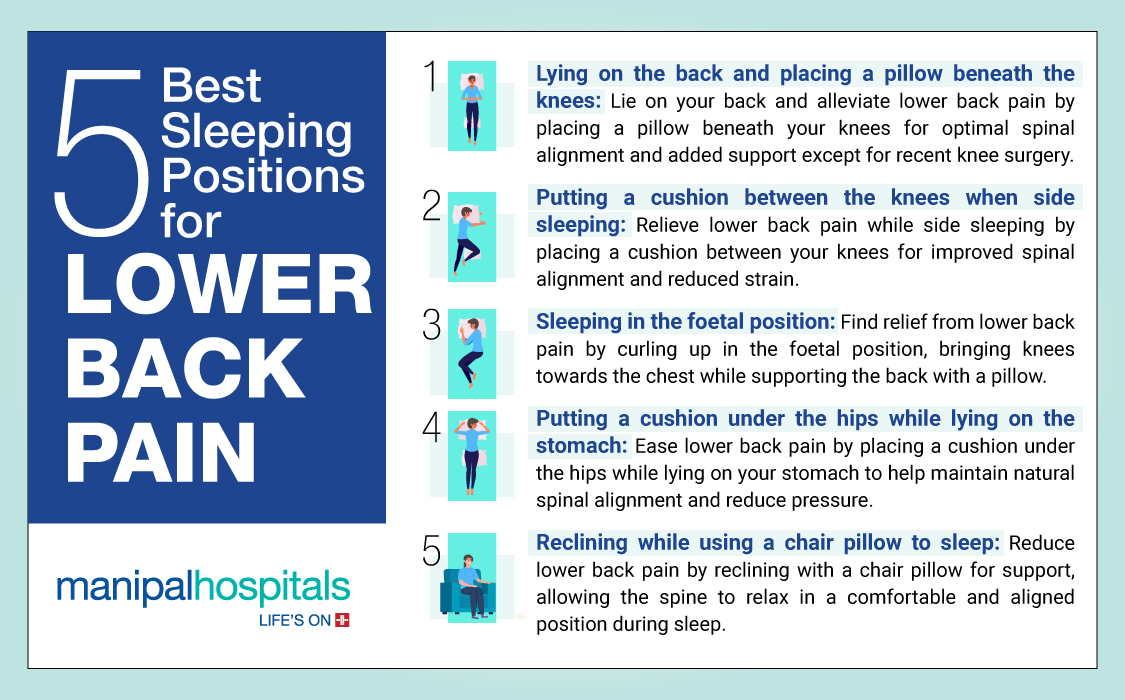
Sleeping in particular positions can either create or exacerbate lower back discomfort, which can influence both a person's sleep and everyday activities. One may get lower back aches and have trouble sleeping. We often do not pass judgment on the sleeping habits of people as it becomes quite difficult to ask patients to quickly regulate and modify their positions.
When someone sleeps, they become unconscious of their body, which can lead to spinal twisting or pelvic tucking. A back injury may worsen, making it difficult to sleep through the night. Supported sleeping positions help keep your back relaxed, minimise the build-up of strains on your spine, and promote recovery. However, if the pain is severe, a proper sleeping posture might enable you to sleep better at night.
Sleeping can be done in any position. There are a few things one can do to make their sleeping posture a little more pleasant if they have lower back pain, according to the specialists at the best physiotherapy hospital in Saltlake, Kolkata. In this blog, we will examine sleeping positions for back pain, five sleeping positions that are beneficial for reducing lower back discomfort so one can get a better night's rest and wake up pain-free.

-
Lying on the back and placing a pillow beneath the knees
By far, sleeping on the back is the ideal position, as our spine is in alignment and our body weight is distributed equally when we sleep on our back. According to the physiotherapist in Kolkata, by doing so, our back is better supported and is not subjected to additional stress or pressure in any area of the back. We should also consider using a pillow to benefit from sleeping on our backs. Our knees can rest on this pillow. To raise our knees and maintain proper spinal alignment, the use of a thick pillow is recommended.
-
Putting a cushion between the knees when side sleeping
If anyone experiences lower back pain, sleeping on the side is a suitable alternative. The main drawback to sleeping on your side is that the lower back's natural bend causes the spine to slip out of alignment. Hence, it is recommended to use a substantial pillow between the knees to correct this and achieve this posture. This position will help provide the alignment that reduces pain. Also, using a pillow between the legs is recommended if someone likes to sleep on their side with one leg tucked in to keep the legs in the same position. In either case, the pillow is essential for avoiding a tight posture.
-
Sleeping in the foetal position
Our lower back will benefit from the foetal position. If someone has hernias, lying in the foetal position will help their spine curve and keep their vertebrae apart while they sleep. Also, it is a comfortable position that can be used to rectify alignment difficulties without the need for cushions. The comfort of having our spine extended as we sleep may be the reason why the foetal position is also a common sleeping posture. One should always choose to sleep on their left side if they want to maintain foetal posture during the night. Deep breathing works best on their left side, which also protects their internal organs from pressure.
-
Putting a cushion under the hips while lying on the stomach
Sleeping on the stomach is often not recommended. However, one can reduce the strain on their back by using a pillow in this position. Generally speaking, while we sleep on our stomachs, our lower back is under a lot of stress because it has to support our lower back as we sleep. Therefore, to mitigate this, one can place a thin pillow beneath their hips to naturally support this area without having to use any muscles if they wish to avoid this discomfort. The pillow must be low because a thick pillow will lead to additional alignment problems. Continued use of a lower pillow that fits under the hips is recommended, but it should not be lifted very high. If someone undergoes recent hip surgery, they should talk to their doctor first.
-
Reclining while using a chair pillow to sleep
Most people find it uncomfortable to sleep in a reclining position. However, some lower back issues can benefit from sleeping in a reclining position. People are advised to have a few alternatives for how to do this. One can spend money on a mattress that has a liftable part that can be used as a chair. Alternately, one can support their slouched body by using a chair pillow. We should never sleep on a recliner chair because they are often not made for all-night use. Using a chair pillow or a movable mattress to achieve the reclining position is recommended while maintaining comfort. To prevent a pressure feeling in the lower back, one can even place an additional pillow there.





















 4 Min Read
4 Min Read















